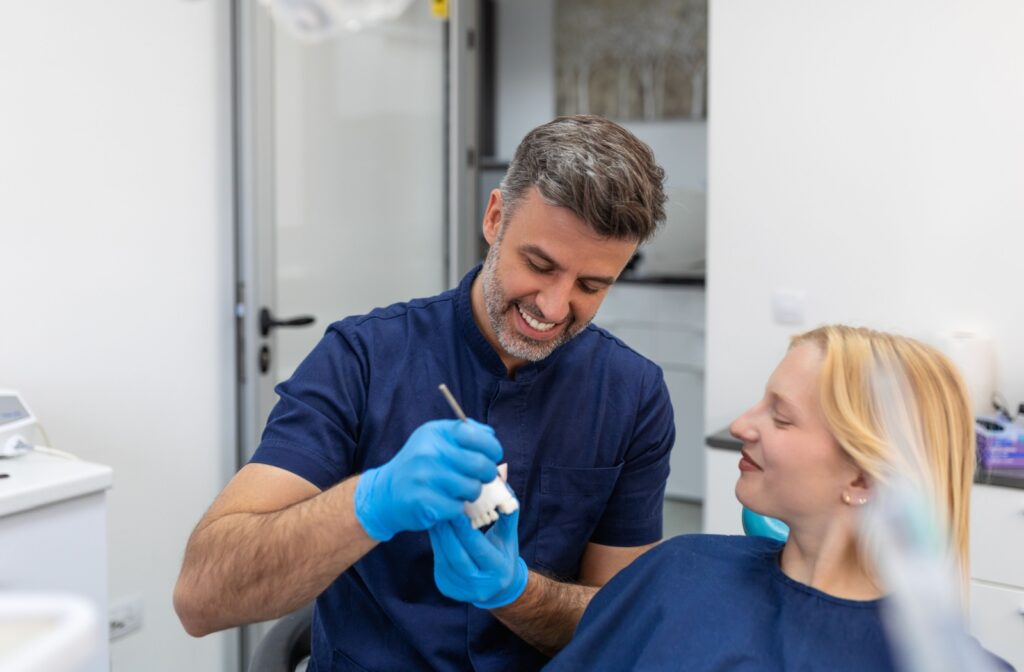Your smile is priceless, and preserving it is worth all the love, care, and attention in the world. Although procedures, like tooth extractions, may appear as a threat to your smile, it’s a necessary last resort to prevent further complications down the line.
Luckily, you won’t have to worry about walking around with a gap in your smile, because we can fill this gap in a few different ways.
Dental implants and dentures are two popular and effective ways to restore gaps in your smile. Each method has its advantages and drawbacks, but the right option is unique to your case.
Dental implants are a more permanent, natural-looking solution, but the process is more invasive. On the other hand, dentures are a tried-and-true, versatile, and non-invasive solution to revitalizing your smile.
Deciding how to fill the gap after a tooth extraction is a big but unavoidable decision. Fortunately, you don’t have to make it alone. Our dental team is here to support and guide you every step of the way!
You Had a Tooth Extraction: Now What?
A tooth extraction might sound intimidating, but nothing in dental care occurs without a reason. Extractions are a last resort, recommended only when necessary to prevent further damage and preserve your oral health.
There are several reasons why your dentist may recommend an extraction, such as:
- Severe decay or infection that damages the tooth beyond repair.
- Overcrowding in your mouth (for example, to make room for orthodontic treatment).
- Impacted wisdom teeth that could harm adjacent teeth.
- Advanced gum disease (periodontitis) causing structural damage.
Put simply, while the idea of losing a tooth may feel stressful, they prevent further complications, such as infections or misalignments.
Obviously, once the tooth is removed, you’ll have a gap in place. Here’s the thing, this gap isn’t immediately filled.
After the extraction, your dentist will focus on allowing the area to heal properly. The healing process can take weeks to months, depending on your unique circumstances, such as the extraction location, the number of teeth removed, and overall health.
Mind the Gap: Why it Needs Filling
This brings us to an important question: do you absolutely need to fill the gap? The short answer is in certain instances yes, and here’s why.
When a tooth is missing, the other teeth in your mouth can shift into this empty space over time. This movement can lead to alignment issues, making it harder to chew, speak, or maintain good oral hygiene. Additionally, leaving a gap unfilled can result in bone loss in your jaw, which may alter the shape of your face and weaken nearby teeth.
Skipping this step may seem tempting, especially if the extraction is further back and is harder to see, but it can be risky. Filling the gap may beessential for maintaining your mouth’s structural integrity and overall health. Not to mention, it can prevent the need for more advanced procedures down the line.

Filling the Gap After an Extraction
Just as no two smiles are the same, the solutions to fill a missing tooth vary from person to person. The method your dentist recommends will depend on factors like:
- The location of the gap.
- How many teeth were extracted.
- The condition of your surrounding teeth and gums.
Your dentist will discuss the appropriate options customized for your unique situation, but here are the most common ways to fill a gap and reclaim your smile.
Dental Implants
Dental implants are one of the most popular and effective solutions for replacing missing teeth. They consist of a titanium post (inserted into the jawbone) acting as the tooth’s root, and a crown to replicate the appearance of a natural tooth.
These implants work because they fuse with your jawbone, helping to prevent bone loss and maintain the structural integrity of your teeth and jaw. Plus, they allow you to easily chew and speak because there’s no shifting around or worrying about loose fittings.
Here are some benefits of opting for dental implants:
- Permanent solution: With proper care, implants can last decades.
- Natural look and feel: Implants closely resemble real teeth in appearance and function.
- Maintain bone health: They stimulate and preserve the jawbone.
- Easy to maintain: Caring for your implants is the same as natural teeth. No special cleaning routines are necessary!
Despite these benefits, there are certain drawbacks to consider:
- Cost: Implants are a significant investment compared to other options.
- Surgical procedure: The process involves surgery to fuse correctly with your jaw bone, resulting in a months-long healing period.
- Not for everyone: Those with insufficient jawbone density may require additional procedures, like bone grafting.
Dentures
Although most people commonly associate dentures with older age, they are a versatile option that can suit various levels of tooth loss. They offer an affordable, non-invasive way to restore your smile, making everyday activities like eating and speaking more comfortable.
Dentures are removable appliances designed to replace missing teeth. They’re custom-made to fit your mouth and can replace a few missing teeth (partial dentures) or an entire set (full dentures).
Opting for dentures has several benefits, including:
- Affordable: Dentures are typically more cost-effective than implants.
- Quick solution: A standard set of dentures is non-invasive, making the overall fitting relatively faster than dental implants.
- Adjustable for different needs: Partial or full dentures can address a range of tooth loss scenarios.
However, there are other factors to consider:
- Feel less natural: Some people find dentures less comfortable than implants.
- Potential for movement: Dentures may shift or loosen over time.
- Maintenance: They require regular cleaning and adjustments.
- Limited lifespan: Even with proper care, dentures generally need to be replaced after 5-10 years.
Reclaim Your Confident Smile
A tooth extraction doesn’t mean the end of your perfect smile. With so many effective options for filling the gap, you can restore your smile’s function and aesthetics. If you’re ready to explore your options, schedule an appointment with our team at Marks Dentistry today!



